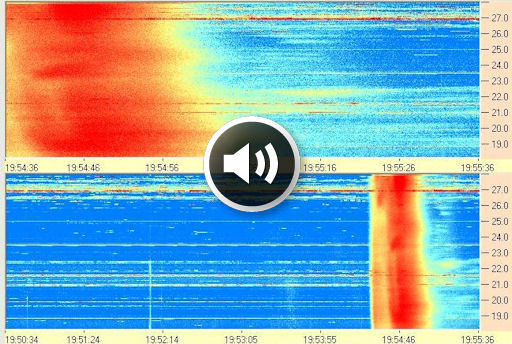
Folks,
Solar Maximum Continues through the Equinox.
This is Far From Over.
UPDATE: 2.2.2013 - spaceweather.com
What's up in space |
SUNSPOT OF INTEREST:
A break in the quiet could be in
the offing. Sunspot AR1667 is crackling with C-class
solar flares and appears capable of producing an
even stronger M-class eruption. The sunspot is turning
toward Earth, so future blasts would likely be geoeffective.
Solar flare alerts:
text,
voice.
LOUD SOLAR RADIO
BURST: Yesterday, Feb. 2nd, the
solar activity forecast called for "quiet."
In fact, says amateur radio astronomer Thomas Ashcraft,
"it was really loud. There were several strong
solar radio emissions including one super-strong
Type III burst at 1954 UT. I captured it at 28 MHz
and 21.1 MHz as it totally drowned out a short wave
voice transmission." Click on the image to
listen:
The source of the burst was sunspot
AR1667, which unleashed a C2.9-class solar flare
just before the roar emerged from the loudspeaker
of Ashcraft's radio telescope. Type
III solar radio bursts are produced by electrons
accelerated to high energies (1 to 100 keV) by solar
flares. As the electrons stream outward from the
sun, they excite plasma oscillations and radio waves
in the sun's atmosphere.
When these radio waves head in the direction of Earth, they make themselves heard in the loudspeakers of shortwave radios around the dayside of the planet.
More radio bursts could be in the
offing. Sunspot AR1667 is crackling with C-class
solar flares and seems poised for even stronger
M-class eruptions.
Solar flare alerts:
text,
voice.
COMET LEMMON UPDATE:
Glowing much brighter than expected,
Comet Lemmon (C/2012 F6) is gliding through the
skies of the southern hemisphere about 92 million
miles (0.99 AU) from Earth. Amateur astronomer Rolf
Wahl Olsen sends this picture from his backyard
in Auckland, New Zealand:
"I took this image of Comet Lemmon
on the 28th of January," says Olsen. "It
has become quite bright now and has also grown a
beautiful tail."
Discovered on March 23rd 2012 by the
Mount Lemmon survey in Arizona, Comet Lemmon is
on an
elliptical orbit with a period of almost 11,000
years. This is its first visit to the inner solar
system in a very long time. The comet is brightening
as it approaches the sun; light
curves suggest that it will reach 2nd or 3rd
magnitude, similar to the stars in the Big Dipper,
in late March when it approaches the sun at about
the same distance as Venus (0.7 AU).
At the moment, the comet is glowing
like a 7th magnitude star, just below the limit
of naked-eye visibility. To capture the faint details
of the comet's filamentary tail, Olsen used a 10-inch
telescope, a sensitive CCD camera, and an exposure
time of 1 hour 17 minutes. Complete photo details
are given here.
Lemmon's green color comes from the
gases that make up its coma. Jets spewing from the
comet's nucleus contain cyanogen (CN: a poisonous
gas found in many comets) and diatomic carbon (C2).
Both substances glow green when illuminated by sunlight
in the near-vacuum of space.
Northern hemisphere observers will
get their first good look at the comet in early
April; until then it is a target exclusively for
astronomers in the southern hemisphere.
On
February 3, 2013 there were 1376
potentially hazardous asteroids.
Recent
& Upcoming Earth-asteroid encounters:
|
>>>
Check this out from solarham.net
solarham.net
You can follow solarham on FB.
Great Resource!
_MP
January AVGs: Solar Flux ---.-
 |
Sunspots --.-
|
Sunspots --.-
 | Flare Max M1.7
| Flare Max M1.7

| Daily Reports WWV | SOLAR REPORT | LATEST ALERTS | SOLAR FLUX |
>>
| >>> | NebShip Radio| FACEBOOK | Message Board | Help Center |

Feb 3, 2013 2:20am
Quick video capturing the C8.4 Solar Flare. Because the flare was impulsive in nature, not much in the way of a Coronal Mass Ejection (CME) is expected. Sunspot 1667 continues to develop and may produce a moderate solar flare within the next 12-24 hours.
Added 02/03/2013 @ 07:50 UTC
C8.4 Solar Flare
Solar activity increased to near moderate levels with a solar flare registering C8.4 at 06:10 UTC. The source of the flare was Sunspot 1667 located in the northeast quadrant. Keep an eye on this region for further activity.

Updated 02/02/2013 @ 14:15 UTC
Solar Update / CME Update
Solar activity is currently low with a minor C1.2 solar flare detected around Sunspot 1665. Sunspot 1667 is producing B-Class activity after rotating into view off the northeast limb. There will remain a chance for C-Class flares.
A CME impact is expected by February 3rd due to an early morning filament eruption on January 31. Only minor geomagnetic disturbances are expected at very high latitudes. Click HERE to watch the latest WSA-Enlil Solar Wind Prediction model.
The Visible Solar Disk (Saturday) - SDO

Sunspot 1665 in CaK (Friday) - Ron Cottrell / Kitt Peak

Be sure to check out this page on SolarHam Facebook and click the "Like" button. You will get the latest updates and more in your news feed.
Added 01/31/2013 @ 17:20 UTC
Northeast Eruption
A large prominence stretching hundreds of thousands of kilometers located in the northeast quadrant erupted on Thursday. A Coronal Mass Ejection (CME) will most likely be flung into space. Images and movie below by SDO. More to follow.
CME UPDATE: As expected, the northeast quadrant prominence eruption on Thursday flung a Coronal Mass Ejection into space. The plasma cloud was directed to the northeast and away from Earth. This image by Lasco C3.

Click HERE for a closer look.






No comments:
Post a Comment